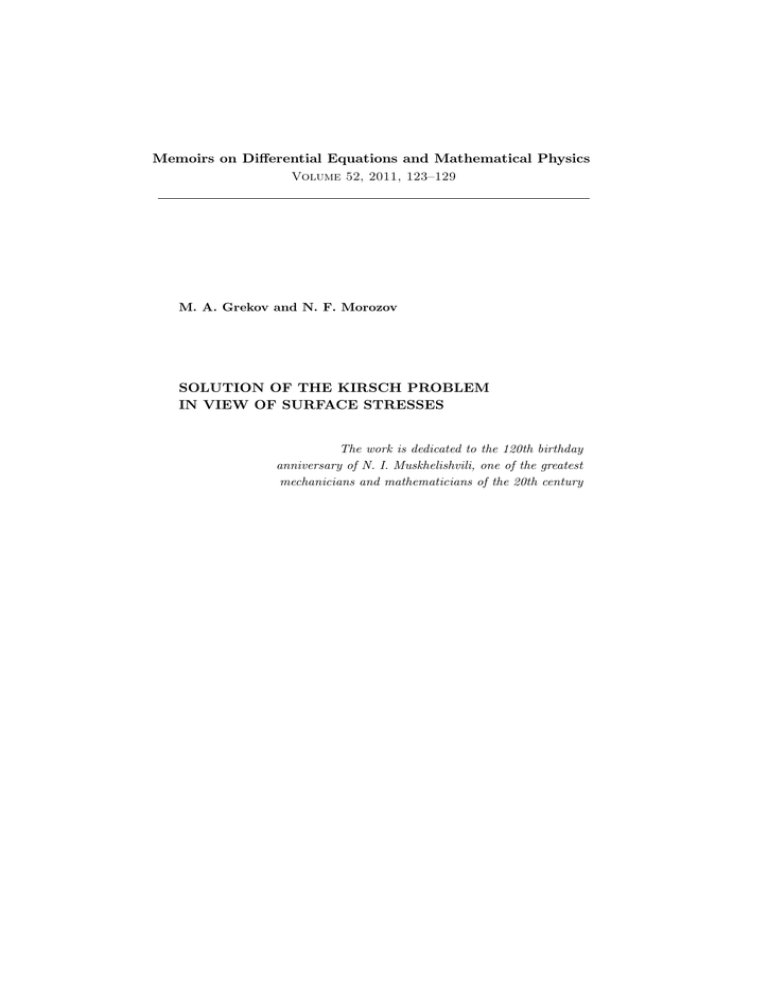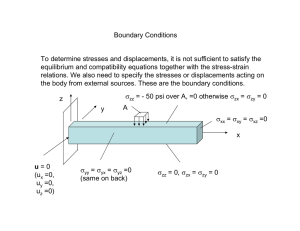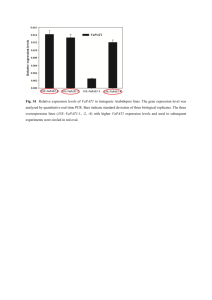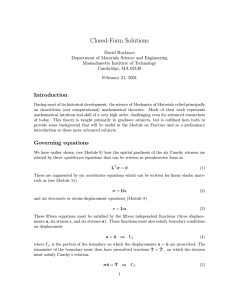Memoirs on Differential Equations and Mathematical Physics
advertisement

Memoirs on Differential Equations and Mathematical Physics
Volume 52, 2011, 123–129
M. A. Grekov and N. F. Morozov
SOLUTION OF THE KIRSCH PROBLEM
IN VIEW OF SURFACE STRESSES
The work is dedicated to the 120th birthday
anniversary of N. I. Muskhelishvili, one of the greatest
mechanicians and mathematicians of the 20th century
Abstract. The Kirsch problem on the tension of an elastic plane with
a circular hole free from external traction is considered. It is assumed
that complementary surface stresses are applied at the boundary. Based
on Kolosov–Muskhelishvili’s method, the solution of the problem is reduced
to the solution of a singular integro-differential equation for an unknown
surface stress. A solution to the obtained equation is derived in an explicit
form and shows that stress concentration at the boundary depends on the
elastic properties of a surface and bulk material, and the radius of a hole as
well if surface stresses are taken into account.
The paper is an example of the modern applications of Muskhelisvili’s
outstanding achievements to the problems of the nanomechanics.
2010 Mathematics Subject Classification. 30E20, 30E25, 74A50.
Key words and phrases. Kirsch problem, surface stress, singular
integro-differential equation, stress concentration.
æØ . Œ ŁæŁ
غø Œ Æ
Æ
ª Ø ª Ł
ª Ł , ºØ Ł ø ª æ Ł
œ Ł
غ Ø Æ
Œ. Æ ª æŁ , ºØ
ª
ØºÆ æŁ Æ Ø
Æ
æŁ œ ª . ºŁººª{Øæ Ł ª Ł Ø ºÆ
غı Œ
Æ ØæŁ Øºø Œ Ø ıª Œ Ł
ŒæŁ æŁ Œ
º-Æ
Œø Łæ
Œ ºŁ
غ Œ ØÆ æøŒº
Æ
æŁ Æ œ æŁº
Ø Ø
. Ø
æŁ
Œ ºŁ
غ Œ ł ß Ł ø Æ
,
ø
æ Ł
ª œŁ ª Æ ª Œ º , ºØ œ ª
ºŒøŒ
ø
ª
Æ Øº Æ æŁ
Ł
æ
ª
Æ
Ø Ł ,
ª ª Ł
Æ æ , æ ª ª Ł ß Œ
Æ
æŁ
œ ª .
ß Øº Æ Œ Œ. Øæ Ł ª Ł
غ ł æŁ Ø øŒ
æŁ Ø ß ª غı Œ
Œ Øæ Œ ŒºØ Œ
Œ Ø Æ ºª
º ŁØ
.
Solution of the Kirsch Problem in View of Surface Stresses
125
It is known, that taking into account surface stresses in rigid bodies [1]–
[4] might be most important for nanoobjects. Here unexpected effects, not
correspond to our traditional representations, may turn out [5], [6].
From these positions the classical Kirsch problem concerning the tension of an elastic plane weakened by a circular hole will be considered.
Assume that complementary surface stresses occur along the boundary of
the circular hole [1]–[4]. The problem will be treated with the help of the
Kolosov–Muskhelishvili method [7].
According to the Laplace–Young law [1], [4], the boundary conditions in
the absence of external stresses on the circular boundary are given as follows
s
s
σθθ
1 ∂σθθ
= 0, σrθ −
= 0.
(1)
r
r ∂θ
s
Here σθθ
is the surface stress, r, θ are the polar coordinates with the center
coinciding with that of the circular hole.
First, we construct a solution for the hole of unit radius and, therefore,
introduce r = 1 in equation (1).
Suppose that the conditions of uniaxial tension along the x1 -axis at infinity are imposed, i.e.,
σrr +
∞
∞
∞
σ11
= σ, σ22
= σ12
= ω ∞ = 0,
(2)
where ω is a turning angle of the material particle.
In the complex writing the conditions (1) for r = 1 take the form
s
σrr + iσrθ = −σθθ
+i
s
∂σθθ
≡ ts ,
∂θ
(3)
where i is the imaginary unit.
To solve the problem, we will apply the Kolosov–Muskhelishvili formulas
[7] which express stresses in the plane σjk and displacements uj (j, k = 1, 2)
in the Cartesian coordinates
x1 , x2 in terms of complex functions Φ, Ψ
p
2
2
holomorphic for r = x1 + x2 > 1:
σ11 + σ22 = 4ReΦ(z),
σ22 − σ11 + 2iσ12 = 2 (z̄Φ0 (z) + Ψ(z)) ,
Z
Z
2µ(u1 + iu2 ) = κ Φ(z)dz − zΦ(z) − Ψ(z) dz̄.
(4)
(5)
Here z = x1 + ix2 , κ = 3 − 4ν for the plane strain, κ = (3 − ν)/(1 + ν)
for the plane stress, ν and µ are, respectively, the Poisson ratio and the
shear modulus of the elastic medium. A quantity with the bar denotes
complex conjugation and the prime denotes the derivative with respect to
the argument.
We will introduce a local orthogonal system of coordinates n, t, rotated
with respect to the system x1 , x2 by the angle α − π/2. Then from formulas
(4), (5) we derive the joint expression for the traction σn = σnn + iσnt on
an element of area with the normal vector n and the displacement vector
126
M. A. Grekov and N. F. Morozov
u = u1 + iu2 [8]
¢
dz̄ ¡ 0
zΦ (z) + Ψ(z) ,
(6)
dz
where G = σn for η = 1 and G = −2µdu/dz for η = −κ. The increment dz
is taken in the direction of the axis t. i.e., along the chosen area element.
Thus in (6), dz = |dz|eiα , dz̄ = dz.
Following N. I. Muskhelishvili’s method [7], we introduce the function
Υ(z), holomorphic in the circle |z| < 1, except the point z = 0, where it
might have a pole up to the second order, inclusive:
G(z, z̄) = ηΦ(z) + Φ(z) +
Υ(z) = −Φ(z̄ −1 ) + z −1 Φ0 (z̄ −1 ) + z −2 Ψ(z̄ −1 ).
(7)
Using equality (7) from (6) we derive the following
·
¸
³ 1 ´´ ³
dz̄ 1 ³
1´ 0
G(z, z̄) = ηΦ(z) + Φ(z) +
Φ(z)
+
Υ
+
z
−
Φ
(z)
, (8)
dz z̄ 2
z̄
z̄
|z| > 1.
We take the limit z → ζ = eiθ in equation (8) and direct the vector n
towards the center z = 0. Since in this case α = θ+3π/2 and dz = −i|dz|eiθ ,
by virtue of conditions (3) from (8) we derive that
Φ(ζ) − Υ(ζ) = ts (ζ).
(9)
Here Φ(ζ), Υ(ζ) are the limiting values of the corresponding functions on
the circumference of unit radius γ.
Introducing the function W (z), holomorphic in the complex plane except
the circumference γ,
(
Φ(z), |z| > 1
.
(10)
W (z) =
Υ(z), |z| < 1
we reduce equation (9) to the following Hilbert problem
W + (ζ) − W − (ζ) = −ts (ζ), |ζ| = 1.
(11)
Taking into account the existence of the pole, a solution to the problem
(11) is written in the form (cf. [7])
W (z) = −I(z) + S(z) + D1 ,
where
1
I(z) =
2πi
Z
γ
ts (η)
c1
c2
dη, S(z) =
+ 2
η−z
z
z
(12)
(13)
and
D1 = lim Φ(z) = σ/4.
z→∞
Since the principal vector of forces applied to the boundary of the hole
equals zero we have c1 = 0, c2 = −σ/2.
Solution of the Kirsch Problem in View of Surface Stresses
127
For the problem under consideration the constitutive relation, connecting
the surface stress and the corresponding strain, takes the form (cf. [4])
s
σθθ
= (2µs + λs )εsθθ , z = ζ,
(14)
where λs , µs are the modules of the surface elasticity, similar to the Lamé
constants of the bulk material.
We impose the continuity constraint on the displacements vector under
passing from the volume to the boundary
lim u(z) = us (ζ),
ζ ∈ γ,
|z|>1
z→ζ
(15)
where us (ζ) is the displacement vector of the boundary point ζ ∈ γ. From
(15) follows the same for the volume deformations εθθ and the deformation
on the boundary εsθθ , i.e.,
lim εθθ (z) = εsθθ (ζ),
ζ ∈ γ.
|z|>1
z→ζ
(16)
The relations (14)–(16) result in the equation for the surface stress
s
σθθ
= (2µs + λs )εθθ , z = ζ.
(17)
The expression for the deformation εθθ is derived by using the relation
(8). Putting in (8) successively dz = dx1 and dz = idx2 for η = −κ, and
z = ζ, after some transformations we find expressions for the deformations
εjk in (x1 , x2 )–system of coordinates. After passing to the polar coordinates
r, θ, we obtain
£
¤
2µεθθ = Re κΦ(ζ) + Υ(ζ) .
(18)
Introducing (18) into (17) and taking into account (10) and (11), we
arrive at the following equation:
£
¤ M (κ + 1)σ ¡
¢
s
σθθ
= −M Re κI − (ζ) + I + (ζ) +
1 − ζ 2 − ζ −2 ,
4
(19)
+λs
where M = 2µs2µ
.
s
Let τ = σθθ . Since ∂τ /∂θ = iζ∂τ /∂ζ = iζτ 0 (ζ), the Sokhotskii–Plemelj
formulas for the Cauchy type integral I(z) acquire the form
Z
τ (ζ) ζτ 0 (ζ)
1
τ (η) + ητ 0 (η)
I ± (ζ) = ∓
∓
−
η,
(20)
2
2
2πi
η−ζ
γ
where the integral is understood in the sense of the Cauchy principal value.
128
M. A. Grekov and N. F. Morozov
Introducing I ± (ζ) from (20) into (19), we obtain the following integral
equation
τ (ζ) −
M (κ + 1)
×
M (κ − 1) + 2
·
¸
Z
Z
1
τ (η) + ητ 0 (η)
τ (η) + ητ 0 (η)
1
×
dη −
dη̄ =
2πi
η−ζ
2πi
η̄ − ζ̄
γ
γ
¢
M (κ + 1)σ ¡
=
1 − ζ 2 − ζ −2 . (21)
2M (κ − 1) + 4
Taking into account the relations η̄ = η −1 , ζ̄ = ζ −1 , τ (η) = τ (η),
ητ 0 (η) = −ητ 0 (η), dη̄ = −η −2 dη, equation (21) for the hole of radius r
transforms into the following singular integro-differential equation
M (κ + 1)
×
M (κ − 1) + 2r
·
¸
Z
Z −1
1
ζ
τ (η) + ητ 0 (η)
η τ (η) − τ 0 (η)
×
dη −
dη =
2πi
η−ζ
2πi
η−ζ
τ (ζ) −
γ
γ
¢
M r(κ + 1)σ ¡
=
1 − ζ 2 − ζ −2 . (22)
2M (κ − 1) + 4r
In (22) we denote η = η1 /r, ζ = ζ1 /r, where η1 , ζ1 are points on the
circumference of radius r.
s
From physical considerations for σ = 0 the surface stress σθθ
is absent.
This implies that the homogeneous equation corresponding to the integral
equation (21), or (22), has only the trivial solution τ = 0.
A particular solution to equation (22) is sought in the form of infinite
sum
+∞
X
τ=
dk ζ k .
(23)
k=−∞
Introducing (23) into (22), after integration and reduction of similar
terms, we get
d0 =
M r(κ + 1)
M r(κ + 1)
σ, d2 = d−2 = −
σ, dk = 0,
4(r − M )
2[2r − M (κ + 3)]
k 6= 0, −2, 2.
(24)
Find now the hoop stresses σθθ on the boundary. From (8), when z →
ζ = eiθ and dz = dreiθ , we obtain
σθθ (ζ1 ) + iσrθ (ζ1 ) = Φ(ζ) + 2Φ(ζ) + Υ(ζ), |ζ1 | = r.
(25)
Using (10), (11)–(13), in view of (23) and (24), the equality (25) yields
σθθ = d0 + 6d2 cos 2θ + (1 − 2 cos 2θ)σ.
(26)
Solution of the Kirsch Problem in View of Surface Stresses
129
The first two summands in the right-hand side of (26) show the influence
of surface stresses on the hoop stress σθθ on the boundary of the hole. The
tensile stress σθθ in the absence of surface stresses attains its maximum at
the points θ = ±π/2 on the boundary of the hole. In the presence of surface
stresses for the value σθθ we get a different formula, namely,
¯
M (κ + 1)[14r − M (15 + κ)]
σθθ ¯θ=π/2 =
σ + 3σ.
(27)
4(r − M )[2r − M (κ + 3)]
It is rather evident from (27) that if M > 0 then for r < M and M (15 +
κ) < 14r < 7M (3 + κ) the stress concentration diminishes when the surface
stresses are present, while for 14M < 14r < M (15 + κ) and 2r > M (3 + κ)
the stress concentration increases.
References
1. M. E. Gurtin and A. I. Murdoch, A continuum theory of elastic material surfaces.
Arch. Rational Mech. Anal. 57 (1975), 291–323.
2. A. I. Murdoch, Some fundamental aspects of surface modelling. J. Elasticity 80
(2005), No. 1-3, 33–52.
3. Ya. S. Podstrigach and Yu. Z. Povstenko, An introduction to the mechanics of
surface phenomena in deformable solids. (Russian) Naukova Dumka, Kiev, 1985.
4. H. L. Duan, J. Wang, and B. L. Karihaloo, Theory of elasticity at the nanoscale.
Adv. Appl. Mechanics 42 (2009), 1–68.
5. V. A. Yeremeyev and N. F. Morozov, On the effective rigidity of a nanoporous
rod. (Russian) Dokl. Akad. Nauk 432 (2010), No. 4, 473–476.
6. P. V. Goldstein, V. A. Gorodtsov, and K. B. Ustinov, Influence of surface residual stresses and surface elasticity on deformation of spherical inclusions of nanometre
sizes in elastic matrix. (Russian) Phys. Mesomechanics. 13 (2019), No. 5, 127–128.
7. N. I. Muskhelishvili, Some basic problems of the mathematical theory of elasticity.
Fundamental equations, plane theory of elasticity, torsion and bending. (Russian)
Fifth revised and enlarged edition. With a supplementary chapter by G. M. Barenblatt, A. I. Kalandija and G. F. Mandzavidze, Izdat. “Nauka”, Moscow, 1966.
8. M. A. Grekov, A singular plane problem in the theory of elasticity. (Russian) Izdatel’stvo Sankt-Peterburgskogo Universiteta, St. Petersburg, 2001.
(Received 06.12.2010)
Authors’ address:
Saint-Petersburg State University
Faculty of Mathematics and Mechanics
Universitetski pr., 28
Saint-Petersburg, 198504
Russia
E-mail: magrekov@mail.ru





